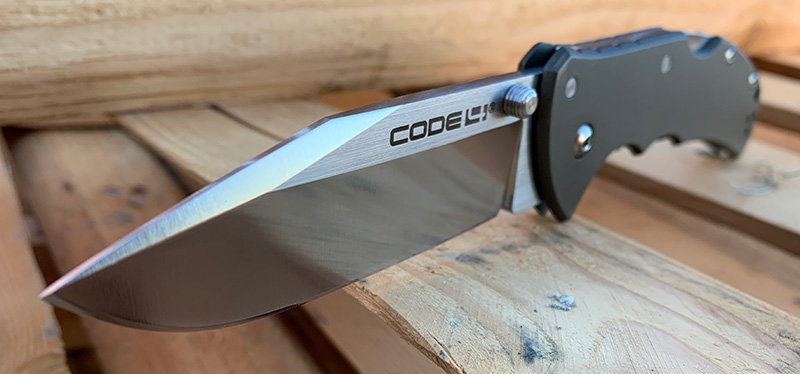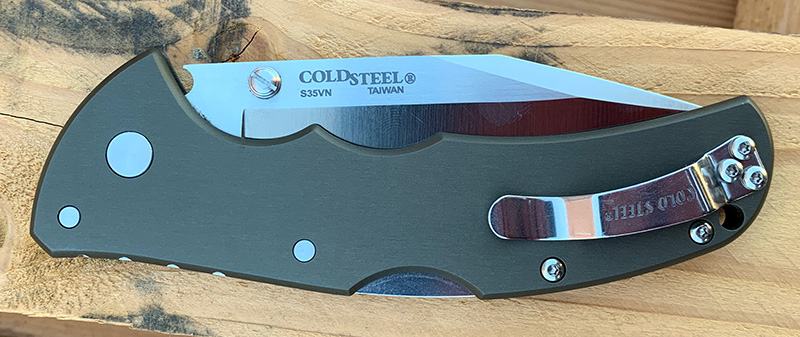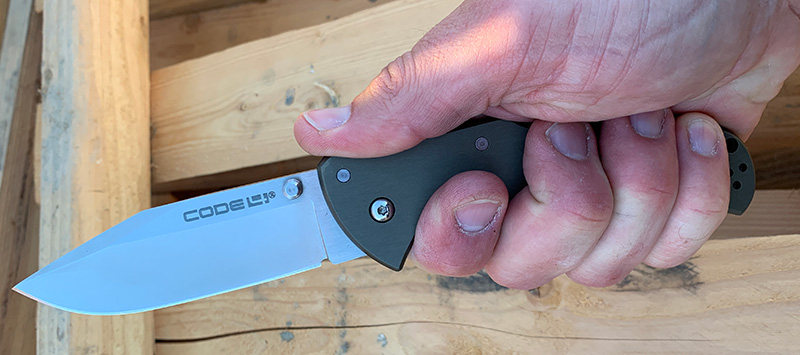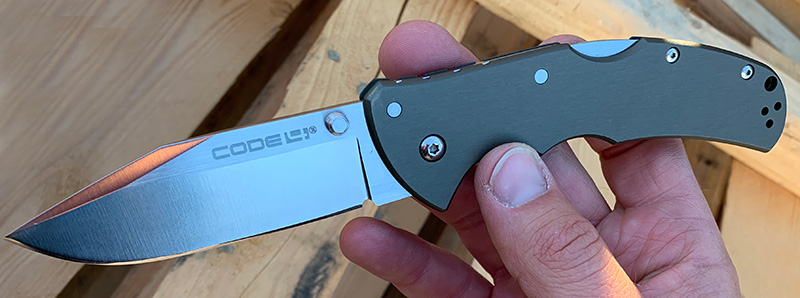We independently evaluate all recommended products and services. Any products or services put forward appear in no particular order. If you click on links we provide, we may receive compensation.
There seems to be a stigma that comes with a brand, whether discussing pocket knives, cars, or anything in between. And Cold Steel is not without that stigma. They’ve been known for many years as the epitome of hard use, overbuilt, tough as nails knives, with their ever popular videos demonstrating over the top testing. Because we all need to know that if you clamp your folder in a vice and hammer on the spine of the blade, the lock won’t fail, right?

Key Specs: Cold Steel Code 4
The Blade
The Code 4 has three blade options; tanto, clip point, and spear point. Our review knife is touting the clip point variant, utilizing the hollow ground S35VN blade steel composition. And it is remarkably great. Hollow ground blades do very well in performance for a number of reasons. Firstly, they tend to come down to a nice thin edge, allowing the blade to initiate a cut quite easily. Secondly, the blade gets out of it’s own way when making long cuts, as in cardboard or styrofoam, where many other blade grinds can get caught up in cutting. And lastly, the edge does not thicken after many sharpening sessions, as the edge comes closer to the hollow grind when more material is worn away, leaving the edge thin for years of use.

S35VN is a great all around steel. I’ll admit that it’s not one I enjoy much in terms of sharpening, as it never truly gets a nice bite to the edge, like higher carbon steel compositions do. But, for a daily use knife, that will see some abuse, and can be touched up on a coffee mug and stropped on a belt, it’s easily serviceable. It also has a decent level of toughness for a stainless steel, and maintains a good level of corrosion resistance. It’s no wonder this steel composition is used so frequently in knives with high quantities of production. With 3.5” of blade on the Code 4, there’s not much that can’t be tackled in terms of daily knife EDC use. And with a .13” blade stock thickness, there’s plenty of confidence translated to the user for anything you might ask of a folding knife.
Cold Steel, in their shameless way, blasts the side of the blade on most their knives with large text. The Code 4 includes the Cold Steel name, blade steel (S35VN), and “Taiwan”. And that’s just on the back side of the blade. On the show side, “CODE 4” is loudly screaming the name of the knife at you and those passing by, just in case anyone with half decent vision wants to know the name of your knife from across the street. Maybe that’s a slight exaggeration, but it’s not entirely untrue. But hey, it’s Cold Steel we’re talking about here, the same company that’s made DVD’s touting the insane use of their knives and swords. It fits, and once you’ve used it for a while, you’ll forget about the bold branding.
Deployment / Lockup
The classic thumb stud deployment of the Code 4 is about what you’d expect from a budget folder, but with some benefits. They protrude from both sides of the blade, and have a tapered shape to them, with chamfered ridges along the length of the stud. This makes them quite comfortable to use, provide good purchase in deployment, and keep from getting the thumb raw after multiple deployments. One oddity they do have, is that the left hand side of the stud is shorter than the right hand side. Although this looks a little weird, it doesn’t seem to matter much, and the studs are removable via flathead screwdriver if you feel the desire to do so, or if you’re left handed.

Deployment of the blade using these thumb studs takes a little getting used to, as the handle of the Code 4 is quite thin. Scratch that, it’s extremely thin. .35” to be precise. Compared to something like the Bugout, which is .42” thick, the Code 4 being such a large knife really feels thin. All this adds up to the deployment requiring the pinky and ring finger of the deploying hand to grasp the pocket clip in order to confidently get the blade moving to the locked open position. But, once that blade is locked open, there’s no arguing that it is locked in the most positive lockup on the block.
There are frame locks, liner locks, axis locks, compression locks, shark locks, ant locks, back locks, and tons of others. But the Triad lock is a bit special, as it incorporates the back lock with an additional point of contact. One argument against a knife like the Code 4 in terms of lock strength is the lack of blade stops, but with a lockup this solid in a knife of this quality, it sure doesn’t feel like it’s missing anything.

Deployment on the Code 4 is quite smooth, despite having 2 points of contact for the duration of the blade moving from closed to open. Back locks are known for not being the most frictionless of actions, but Cold Steel does a great job with their Triad lock. Unlocking the blade requires the back lock mechanism to be depressed quite far into the handle, which insures the lock won’t be accidentally depressed in use, but does take a bit of force to get the blade out of the locked position.

I don’t personally mind it much, but some people who have borrowed the knife from me for a quick task had commented on the “stiffness” of the lock bar. I, for one, would rather have a tighter lock than one that can move around on me, so I prefer this tigher lock to something like the Spyderco Delica / Endura / Endela that seem to flex around quite a bit. And speaking of tightness, the lockup on the Code 4 is incredibly tight. Even with the blade penetrated into a 2×4, I wasn’t able to wiggle any discernable blade play side to side, or front to back. This thing locks up like a fixed blade. I love that.
Features, Fit and Finish
We’ve discussed the S35VN blade steel, but haven’t taken any time to admire the 6061 aluminum handle scales of the Code 4. I personally like the gun metal gray used on their aluminum here, and the texturing is just right. Not too smooth, not too grippy, just right. The handle scales are also notched for finger grooves, which have to be done right for one to appreciate, or they run the risk of really being bothersome. The Code 4 has been done right, and allows the hand to move around a little within the grip offered by the grooves. They’ve even managed to contour the scales around the edges to reduce the amount of discomfort felt in hand when gripping the knife tightly.

We’ve also discussed the Triad lock, but what’s hiding under the pivot is a nice surprise for an $80 knife; phosphor bronze washers. Many budget knives will resort to either Teflon washers (which I actually still admire), or no washers at all, allowing the blade to ride directly on the aluminum. This isn’t terrible, there are many knives that still do this, such as Microtech’s side autos (the Stitch and LUDT are examples of this), or even FRN, such as Spyderco’s Native 5 lightweight. There are many ways to do a pivot on a budget, but for Cold Steel to splurge on phosphor bronze, with the extra smoothness and rigidity they provide is a nice touch in this price range.
Of course, at this price point, there will be some kind of unfinished business in terms of fit and finish. The back spacer doesn’t sit perfectly within the handle scales, the very lightly textured jimping along the handle scales is not highly precise, but it’s not all bad. The knife feels well built overall. There’s not any creaking or cracking, no rattling around of any kind, no burrs on the screw heads, it’s all just dandy. If you’re not afraid of buying products made outside the USA, this is a great avenue. The blade comes plenty sharp, everything works well out of the box, and it’s very reliable.
Field Test
Ah, the field test. Or better known in my realm as the garage test. I typically will move around through my usual paces of knife testing in the garage, cutting sisal rope, cardboard boxes, shaving 2×4’s, and then to the kitchen for some apple slicing. The sisal rope is a great test of the edge, as many steels will roll or dull easily at the edge just after a few cuts. The Code 4 seemed to hold it’s own in this regard. The ergonomics proved to work well, with the finger grooves once again lining up just where I’d place them if I had made the knife myself. Using the knife in this test often requires my thumb to press down on the spine of the blade to put extra force down on the rope, and the Code 4 was no exception here. I did notice that the spine of the blade was not chamfered on it’s edges, which didn’t create too much undue discomfort, but it was noticeable. Again showing it’s lack of high end finish, but also proving that it typically doesn’t affect the use of the tool in any way.

In breaking down some cardboard boxes, I noticed myself (as I usually do) using a pinch grip on the handle. There is a spot on the blade near the heel that is unsharpened, that looks like wasted space. I found it to be a place to choke up on the blade in this grip, so long as the user is quite careful as to not slide up into the sharpened portion. While we’re here, I’d also like to mention that this spot on the blade also helps in unlocking the knife one-handed, when the back lock is actuated with the thumb (as it almost has to be with the strength of the spring), the blade is allowed to fall forward onto the index finger, in the unsharpened portion of the blade. With the blade stopped from freefalling in this position, the knife can be turned in the hand, removing the fingers from the blade path, and completing the close of the knife without the use of a second hand. I commonly look for a way to use my folders one-handed, as my second hand is frequently being used for another task when my knife is required. Back to the cardboard cutting, the hollow ground blade performs as expected, in conjunction with the satin blade finish, to rip through the boxes quite smoothly, without much resistance.
In a harder use test of the ergonomics, I like to push the knife harder than what it’s normally used for. Not in the sense that I’m looking to test it’s mechanical limits (although I do enjoy a good beating on a knife, in a safe manner), but to test the true ergonomics of the knife. It makes me chuckle, watching videos of knife reviews, where the reviewers hold the knife and mention it’s ergonomics, whether for better or worse. When the knife is pushed back into the hand in actual use, things can change. And the Code 4 showed a little of it’s ugly side in the ergos during this test.

The blade does a great job of making some feather sticks for fun, but both the thin construction of the handle scales as well as the somewhat sharp nature of the aluminum where the scales create the opening for the blade, work against the user a bit when pushing down harder on the knife. It’s the kind of discomfort that puts an indent on the hand after just a few seconds of use, so I’d argue that this knife would be difficult to use say, on a camping trip where you may want to actually cut some smaller sticks of wood to make a fire. But, it is a folding knife, which always has inherent limitations, and virtually no pocket knife can be without fault in some way. These tests just go above and beyond typical EDC use, to see how the execution of engineering translates to real use, in ways that may not be obvious to potential buyers just by pictures or videos alone.

Carrying the Code 4 is surprisingly good. With it’s extremely thin profile, it sits in the pocket quite comfortably. The aluminum scales allow the knife to slide in and out of the pocket quite easily, and the clip has great retention. Another note on the pocket clip, in my use and testing, it seemed to always land in my palm in a way that made it feel invisible. I highly appreciate when knife manufacturers are able to make a clip both work well for retention, but also work well in use. Pulling the knife from the pocket, using it for any common task, and putting it back in the pocket feels natural, once you’re used to the slim profile. With a weight of 4.15 ounces, and a handle length of 5 inches, it sounds like a huge knife. And while it’s not small, the thin profile really helps it feel smaller than it is when carrying it, but just as big as it sounds in use. This is also a completely ambidextrous knife, since the pocket clip can be swapped to the opposite side, the lock bar is dead center on the back of the knife, and the thumb stud (while offset on each side, but again being reversible), it can be used by righties and lefties alike.
Alternatives
All these knives available at BladeHQ.
With a price tag of ~$80, and a build quality that’s meant for heavier use and long term durability, it can be challenging to find comparable knives to the Code 4. But there are some contenders that may vary in some ways, but have similar qualities. Spyderco’s Endura 4 is one good option when looking at alternatives to Cold Steel’s Code 4. With a blade length of 3.75”, a handle length of 5”, and a handle thickness of .45”, the Endura has quite the similar footprint to the Code 4. The Endura does cost $91, an increase of $12 over the Code 4, but I’d say in this price range, that’s close enough. The Endura also uses a back lock, but without the additional strength of Cold Steel’s Triad lock (which just means it has a stop pin for the blade to rest against versus the blade resting straight on the lock bar). Spyderco’s variant comes with VG10 steel in it’s basic form, but also has a range of color options and steel choices, in Spyderco’s typical fashion.
Another Cold Steel knife that rivals it’s own Code 4, is the Recon 1. It also has a number in it’s name, so it’s gotta be similar, right? Ok, dad jokes aside, the Recon 1 has been part of Cold Steel’s lineup for many years. It uses the same CPM-S35VN blade steel, but the blade length reaches out a touch further at 4”, a handle length of 5.375”, and a bump in weight to 5.3 oz. So it’s bigger, heavier, and longer, but trades the aluminum scales of the Code 4, for G10. Using a similar clip point blade profile, and similar specs overall, it pits itself against the Code 4 quite well, but bumps the price tag up an even $20, to $99 for the Recon 1. These two knives share the Triad lock as well, so they’re both sure to pass the insane spine whack machine test Cold Steel puts their folders through with flying colors.

Conclusion
Whether you’re looking for a knife that is used occasionally, or used frequently, a knife that is built quite well but doesn’t break the bank, and one that can be forgotten about on the shelf in any climate thanks to decent build materials and stainless blade steel, the Code 4 is sure to please most users. I don’t think one could go wrong in adding a Code 4 to a collection, or as a one-and-done knife user. It’s functional, utilitarian, rugged, and cheap. But it doesn’t feel lacking, especially for it’s price. I’ve handled and used hundreds of knives, and I truly struggle trying to think of a better value for the money. I like to carry knives that I know I can trust in any situation, and use without fear of damaging or even losing the knife. And the Code 4 carries all these attributes, and looks good while doing it. I do understand many users here in the USA keep their money spent on goods and services manufactured in their home country, but if you’re not bothered by purchasing a knife made overseas, the Code 4 is tough to beat.
- Low price, good materials, strong construction, comfortable to use and carry, performs admirably.
- Not USA made, extremely thin profile challenges ergonomics, quite large overall for common EDC use.
Cold Steel Code 4
Quality/Performance - 75%
Value for Money - 86%
81%
The Code 4 is functional, utilitarian, rugged, and cheap. Great value for money.





